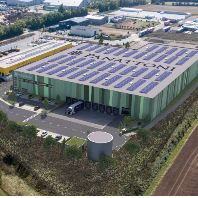In the second half of 2010 WarehouseMatch.com identified a clear shift in search patterns for smaller warehouses. After examining the results with their partner Logireal.com they have identified three plausible causes for the shift - new distribution strategies, risk averse decision making or changing distribution channels.
Everybody who is investing in the European logistics real estate market knows the Blue Banana Belt and the Golden Triangle. The Blue Banana Belt stretches from London, Brussels, Frankfurt to Milan and is one of the most densely populated regions in Europe. A warehouse located within this belt can reach 70% of the total European market within one-day trucking. The Golden Triangle stretches from London, Paris to Dortmund. This area accounts for 69% of all European logistics' handling.
In the last five years the biggest demand was to be found in this area causing a large investment wave throughout Europe for logistics real estate. There is currently a lot of availability in the market ready to be filled by future logistics operations. Is this a problem?
Analysis of WarehouseMatch.com search results
After partnering with LogiReal, WarehouseMatch decided to analyze the European search data every six months to give the market a good overview about current market demand. In this overview we have analyzed the period June 1, 2010 until December 21, 2010, containing 10.733 search requests. Looking at the numbers provided by WarehouseMatch.com we see a huge amount of search requests in the west in a Platinum Rectangle from Rotterdam to Calais and Venlo/Liege and in a straight line to Leipzig/Prague, with an average requested surface of 21,500 m².
Almost 75% of the searches received by WarehouseMatch.com are in the range between 0 and 5,000 m² as a result of new e-commerce growth in the market. This confirms the shift to the middle as these companies also look for logistics services in the Golden Triangle for their European distribution.
The data of 5,000 m² and above still show the normal patterns of the Blue Banana Belt as the larger supply chains have a need to deliver to all regions of Europe, but if we take a look at the density of these searches almost 70% of the locations are in the new Platinum Rectangle.
Conclusions
The observed deviations in search behavior are premature and need to be revisited in the course of 2011 to see if they hold out. In the meantime we see three possible causes in the change of search behavior:
1. New distribution strategies
In response to the economic crisis companies are revisiting their distribution strategies. They have come to the conclusion that they need to be more responsive to handle changing market demands. Such responsiveness requires lower inventories and shorter distribution lines. This results in the need for more and smaller warehouses. Hence, big warehouses are permanently less attractive and companies are searching for smaller warehouses.
2. Risk averse decision making
The economic crisis has made companies risk averse. With the crisis coming to an end, demand is slowly increasing again, but companies are careful in expanding too quickly (again). In addition, funds to finance increased inventory levels are still limited. Hence, big warehouse are temporarily less attractive and companies are for the time being searching for smaller warehouses.
3. Changing distribution channels
The use of internet is creating a boom in internet sales. The distribution of the goods purchased through such web-based companies requires a combination of a few international large warehouses (hubs) and many local cross-docking locations for the fine-distribution to the end users. This is partly supported by the increasing emergence of courier and package delivery services. This also explains the still existing searches for big warehouses, but the increasing searches for smaller warehouses.
Source: LogiReal













